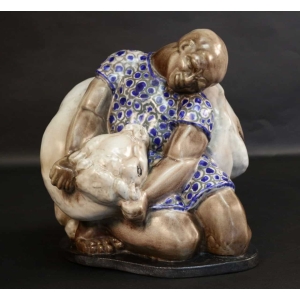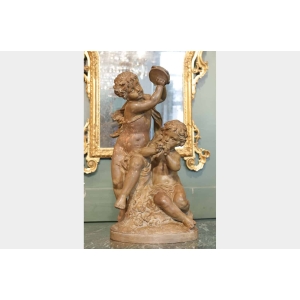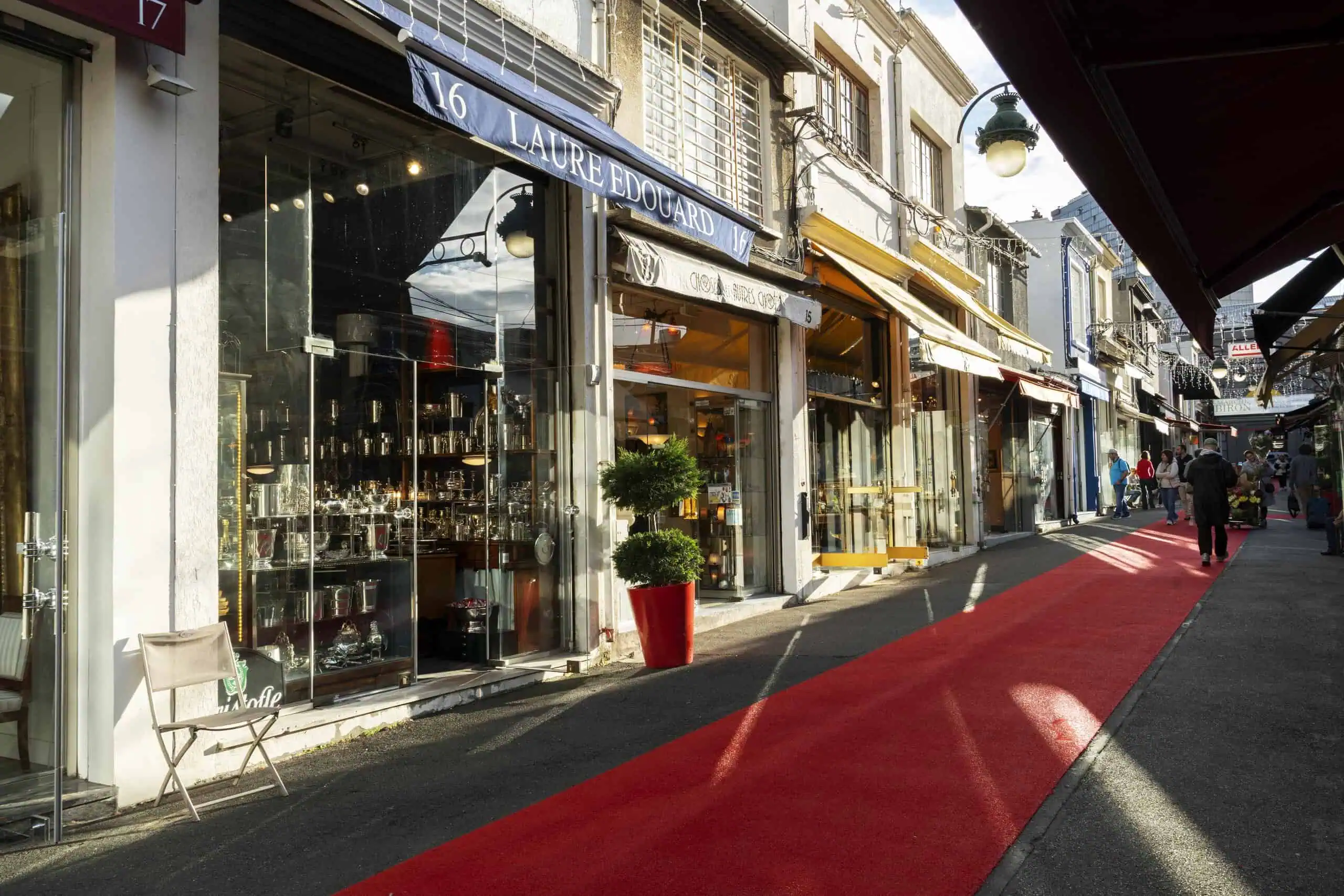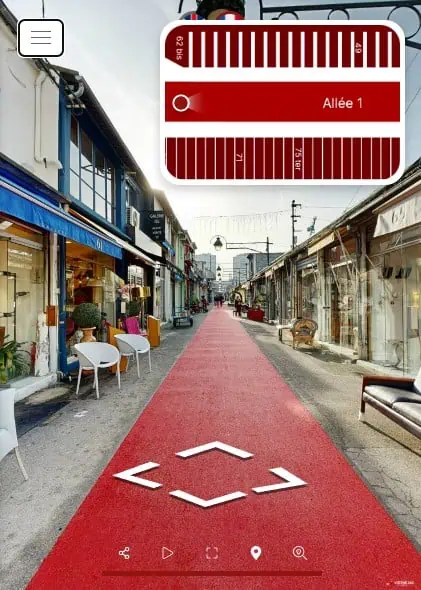Plateau-Présentoir de forme rectangulaire en porcelaine à décor polychrome sur fond Bleu Céleste moucheté de bouquets de fleurs, d’une composition inspirée des « Amours Oiseleurs » (1733) de François Boucher (1703-1770) inscrits dans des réserves cernées de palmes, feuillages et motifs floraux peints à l’or. Monture en bronze doré ciselé d’inspiration sinisante à motifs de créatures chimériques, d’entrelacs géométriques ajourés. Piètement quadripode à enroulement. Travail parisien de belle qualité d’Epoque Napoléon III à rattacher aux créations de la Maison Alphonse Giroux et Cie (1838-1867), -haut-lieu « de la fantaisie, de l’art et de la curiosité ». Circa 1860.
Combinant avec raffinement, piquant au gracieux répertoire décoratif hérité du XVIIIe siècle français une riante touche d’exotisme dérivée d’un Extrême-Orient onirique, cet original et séduisant plateau-présentoir réalisé en porcelaine et bronze doré ciselé illustre à merveille ce type d’ objets d’art « délicieux de fantaisie élégante »conçus par d’émérites Maisons parisiennes du Second Empire ( Alphonse Giroux et Cie, Tahan, L’Escalier de Cristal) pour une clientèle éprise de leurs inventives et luxueuses créations.
Rehaussé d’une frise à motif de festons stylisés, un encadrement de bronze doré à pans incurvés arrondis sertit une ample pièce porcelainière de forme rectangulaire faisant office de réceptacle. Nimbée d’un fond bleu Céleste poudré et moucheté, celle-ci déploie en son centre, enveloppée de palmes, de motifs floraux et brindilles feuillagées peints à l’or, une ravissante composition polychrome sur réserve d’un blanc laiteux. Au sein de nuées galonnées de pimpants jetés de fleurs, sont mis en scène auprès d’une cage en osier deux souriants bambins aptères aux formes potelées soulignées d’aériens drapés: séant sur un tambour, l’un lutine avec deux colombes aux gorges gansées d’un fin ruban; chevauchant un carquois, l’autre, accoté à un nid, brandit une brindille de blé. En écho à cet enjoué tableautin librement inspiré des » Amours Oiseleurs » aussi titré « L’Eté » (1733, Providence, Muséum of Art, Rhode Island Scholl of Design) ou de l’oeuvre gravée (L’Amour Oiseleur et son pendant L’Amour Moissonneur, Paris, Musée du Louvre, Département des Arts Graphiques, Inv. 18852 et 18853) de François Boucher (1703-1770), de menus bouquets de fleurs champêtres peints « au naturel » épanchent en quatre cartouches circulaires leurs pimpantes couleurs.
D’une insolite inspiration sinisante, une monture en bronze doré allègrement ciselée ajoute une indèniable note de fantaisie à ces ravissantes compositions peintes témoignant au coeur du Second Empire du pérenne engouement -aux côtés de ses Nymphes, Bergères-pour les Putti ou « Enfants » de François Boucher. Chimériques créatures (masque grimaçant de Chien de Fô, têtes de gargouilles au cheptel flammé), entrelacs ajourés de motifs géométriques imbriqués , rosace de fleur exotique stylisée, volutes lobées animent ainsi les anses, enjolivent les bords et scandent le piètement de ce plateau-présentoir.
Doté d’un parti décoratif jouant la légèreté, la sophistication, cet objet d’agrèment est à rapprocher par sa composition originale, son alliance de matériaux et répertoires ornementaux alors forts prisés comme par sa qualité d’exécution des réalisations émanant plus particulièrement de la Maison Alphonse Giroux et Cie (1838-1867).
Travail parisien de la seconde moitié du XIXe siècle, de Style eclectique. Epoque Napoléon III, circa 1860.
Rectangular-shaped porcelain tray-display with polychrome decoration on a Celestial Blue background speckled with bouquets of flowers, of a composition inspired by « Amours Oiseleurs » (1733) by François Boucher (1703-1770) inscribed in reserves surrounded by palm leaves, foliage and floral motifs painted in gold. Chiseled gilt bronze mount of Sinic inspiration with motifs of fanciful creatures, openwork geometric interlacing. Roll-up quadripod base. Parisian work of good quality from the Napoleon III period to be linked to the creations of Maison Alphonse Giroux et Cie (1838-1867), – high place « of fantasy, art and curiosity ». Circa 1860. Combining with refinement, pungency to the graceful decorative repertoire inherited from the French 18th century, a cheerful touch of exoticism derived from a dreamlike Far East, this original and attractive display tray made of porcelain and chiseled gilt bronze is a wonderful illustration of this type of « delicious, elegantly fancy » art objects designed by distinguished Parisian houses of the Second Empire (Alphonse Giroux et Cie, Tahan, L’Escalier de Cristal) for a clientele in love with their inventive and luxurious creations. Enhanced with a frieze with a pattern of stylized festoons, a gilt bronze frame with rounded curved sides sets a large rectangular porcelain piece that acts as a receptacle. Enveloped in a powdery and speckled Celestial blue background, it deploys in its center, wrapped in palm leaves, floral motifs and leafy twigs painted in gold, a delightful polychrome composition on a milky white reserve. In the midst of clouds laced with dapper flowers, are staged near a wicker cage two smiling flightless toddlers with chubby shapes underlined by draped aerials: seated on a drum, one elves with two doves with braided throats with a thin ribbon; riding a quiver, the other, leaning against a nest, brandishes a twig of wheat. Echoing this playful painting freely inspired by « Amours Oiseleurs » also titled « Summer » (1733, Providence, Museum of Art, Rhode Island Scholl of Design) or the engraved work (L’Amour Oiseleur et son pendant L ‘Amour Moissonneur, Paris, Louvre Museum, Department of Graphic Arts, Inv. 18852 and 18853) by François Boucher (1703-1770), small bouquets of country flowers painted « au naturel » pour out their dapper colors in four circular cartouches. With an unusual Sinic inspiration, a cheerfully chiselled gilt bronze mount adds an undeniable note of fantasy to these delightful painted compositions testifying to the heart of the Second Empire of the perennial craze – alongside its Nymphs, Shepherdesses – for the Putti or « Children ». by Francois Boucher. Chimerical creatures (grimacing Fô Dog mask, gargoyle heads with flamed livestock), openwork interlacing of interlocking geometric patterns, stylized exotic flower rosette, lobed scrolls thus enliven the handles, embellish the edges and punctuate the base of this display tray . Endowed with a decorative element playing on lightness and sophistication, this ornamental object is to be compared by its original composition, its alliance of materials and ornamental repertoires then highly prized as by its quality of execution of the achievements emanating more particularly from the Maison Alphonse Giroux et Cie (1838-1867). Parisian work from the second half of the 19th century, in an eclectic style. Napoleon III period, circa 1860.
























